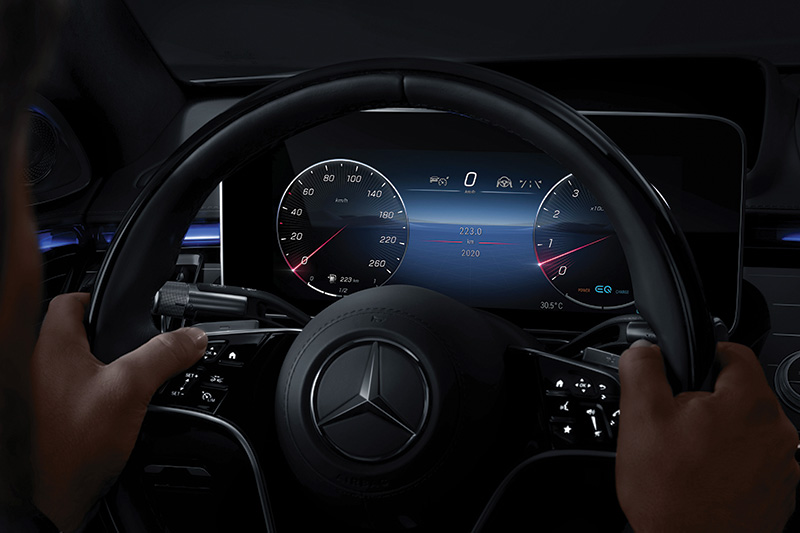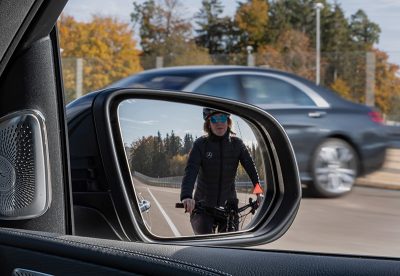Blind spot assist systems use not only radar sensors, but also wheel speed sensors, steering angle sensors, door control modules, exterior mirrors, the entertainment system antenna, and more. For models with active blind spot assist technology, add anti-lock braking, electronic stability program, and other systems.

Blind spot sensors and assist technologies have been on various Mercedes-Benz models for over a decade. Blind spot assist systems detect vehicles in the blind spot using a radar measuring process. Radar sensors emit electromagnetic waves that are reflected off of any obstacle in the blind spot target range. The reflected signal is received back by the radar sensor of the corresponding wheel.

How reflected electromagnetic waves pinpoint objects:
- Travel time of the reflected signals = Distance to the object
- Direction of reflection = Location of the object
- Intensity of the echo (reflected signal) = Size of the object
- Frequency (signal) shift = rate of movement of the object
Pay attention to system names, as there are different blind spot technologies and diagnostic procedures on various Mercedes-Benz models.
Early systems used a series of progressively more attention-getting warning technologies, including blinking lights in exterior mirrors and the dash, audio chirps and beeps, and haptic (vibration) in the steering wheel, to alert drivers that there was an obstacle in their blind spot. These ’warning-only’ systems are called “Blind Spot Assist.â€
Technologies introduced on 2014 and newer models added the ability of the vehicle to autonomously initiate braking if the driver fails to respond to warnings with the appropriate avoidance maneuvers in a timely manner. Brake actuation is only at the wheel (or wheels) necessary to alter vehicle direction back toward the center of its original lane. Braking is intended to course-correct rather than stop the vehicle. These autonomous systems fall under the “Active Blind Spot Assist†label.
The shorthand for these systems is a code that identifies which blind spot technology is on a given Mercedes-Benz model. Option code 234 refers to Blind Spot Assist, while code 237 indicates Active Blind Spot Assist systems. You can find these (and other) codes on the vehicle data card, available in the Mercedes-Benz Parts Information (formerly EPC) application, as well as in the Workshop Information System (WIS) available through STAR TekInfo.
Other Mercedes-Benz systems also use these radar sensors. Rear bumper-mounted sensors on models with code 234 (Blind Spot Assist) are called an “intelligent radar sensor.†On models with code 237 (Active Blind Spot Assist), code 238 (Active Lane Keeping Assist), or code 253 (Rear-end collision warning and protection system), the sensor is labeled simply “radar sensor.â€

Precision Tracking
Mercedes-Benz engineers chose ultra-wideband radar sensors for their high bandwidth and powerful detection properties. The high frequency bandwidth offers precision tracking of objects behind or around the vehicle, with clear separation of even those that are close to one another. The left and right rear bumper radar sensors can detect objects as far as about 30 meters (33 yards) away with a resolution accuracy within 40 mm (1.6 inches). The center rear bumper radar sensor recognizes vehicles to the rear up to 80 meters (88 yards) away at a resolution of as fine as 50 mm (2 inches).

Control Unit Communication via CAN System
On the 2014 and newer E350 (W212) with Lane Tracking (code 22P) or with Driving Assistance Plus (code 23P), the sensors mounted in the rear bumper have their signals analyzed and are actuated by the video and radar sensor system control unit (N62/2 in the wiring diagram). Signals to and from the rear bumper sensors are transmitted via Radar CAN 2. Front bumper sensors used for DISTRONIC systems transmit signals via CAN 1. The left and right rear sensors are identical, with one electrical pin (5 or 6) connected to ground (Circuit 31) to indicate which side of the vehicle they monitor.

Blind Spot Monitoring Master Signal
The E350 from 2014 and up with the intelligent radar sensor system (code 234 – Blind Spot Assist) sends signals from the left rear bumper intelligent radar sensor to the right rear bumper intelligent radar sensor rather than directly to the control unit. The right rear bumper intelligent radar sensor functions as a master unit, evaluating data from both intelligent rear bumper sensors and sending the appropriate data or action requests via Chassis CAN 1 to the radar sensors control unit (N62/1).
Role of the Wheel Speed Sensor
Wheel rotation direction and speed are recorded by rpm sensors at each axle. Wheel speed sensor signals are read in directly by the appropriate control unit based on vehicle model and BSM system type, and then sent by the control unit over the chassis CAN. This applies to Mercedes-Benz vehicles with:
- Electronic Stability Program control unit (N30/4) with code 234 – Blind Spot Assist
- Regenerative braking system control unit (N30/6) with code 234 or code 237 – Active Blind Spot Assist
- Premium Electronic Stability Program control unit (N30/7) with code 237.
Control unit software algorithms calculate the distance, speed, and angle of approach of the oncoming vehicle (or obstacle). Once a vehicle is determined to be in the blind spot zone, the BSM control unit then sends commands to the door control units to actuate caution lights in the exterior mirrors. If the vehicle begins moving across the lane edge on the side where there is another vehicle in the blind spot, the control unit initiates an audio warning, and a haptic (vibration) alert through the steering wheel. On models with Active Blind Spot Assist, the control unit sends signals that actuate braking action on the appropriate wheel or wheels to pull the vehicle back into its original lane.
A problem with a wheel speed sensor, a door control unit, or an anti-lock braking control module could thus affect the performance of the blind spot monitoring system.
The Multifunction Antenna
In vehicles equipped with radar sensors, regulations require that in certain areas of radio sensitivity the sensors must be disabled. This function depends on a valid Global Positioning System (GPS) signal. All control units involved in the navigation system function receive global positioning system (GPS) signals via the multifunction antenna (A28/11). One hint to point you toward the multifunction antenna is that in addition to a BSM problem, the customer also complains of issues with the key fob. A SmartKey that starts the engine but does not lock or unlock doors or the trunk may not be receiving a signal from the multifunction antenna. This applies to models with any of three different types of entertainment system.
- Radio (A2) with code 523 or code 510, in combination with telematics CAN-adapted navigation module with code 509
- Radio with auto pilot system (A2/56) with code 511 or code 525
- COMAND controller unit (A40/3) with code 512 (DVD changer) or code 527 (single DVD drive) with navigation.
Of course, if BSM is consistently disabled (indicated by a warning in the instrument cluster) in a certain geographic area, it may be one of those radio-sensitive areas and not a system fault.
Steering Angle Sensor
The Blind Spot Monitoring system analyzes data from the steering angle sensor (SAS) to determine the direction in which the vehicle is headed. If the SAS is failing, the BSM cannot accurately project vehicle direction and determine whether the risk of imminent collision meets the threshold for generating warning alerts or initiating corrective braking action.
Radar Sensors
Several general issues can cause faults with the radar sensor or its connections.
1. Moisture contamination and dirt: The most likely causes of a malfunctioning intelligent radar sensor are moisture contamination in the sensor housing, or dirt or a foreign object blocking the sensor. Your customer may report receiving a Blind Spot Monitoring (BSM) error message often during rainstorms.
First, check for debris blocking the sensor. The BSM sensors are not completely enclosed on some Mercedes-Benz models. Dirt on the sensor can prevent proper function. Remove and clean the sensors. Reinstall the sensors, ensuring proper seating for a good seal.
If the fuse for Blind Spot Monitoring reacts to excessive current and cuts power, the wiper blades and rear turn signals may also no longer function. On some Mercedes-Benz models, the wipers and rear turn signals are protected by the same fused circuit as the BSM sensors in the rear bumper. If you see both BSM and turn signal or wiper blade problems, check the fuse that is shared by the radar sensors, the wiper blade system, and the turn signals. Identify and eliminate the cause for overcurrent and replace the fuse.
2. Incorrect sensor configuration: After moisture contamination or dirt blocking the sensor, the next most likely cause of an intelligent radar sensor malfunction trouble code is that the component is configured incorrectly, or was not configured at all after installation. Configuration is fastest using a Mercedes-Benz scan tool, but it can also be done manually. XENTRY Diagnosis guides you through an efficient, relatively automated diagnostic and configuration process. Refer to the Mercedes-Benz repair information whether you choose to configure the sensor with XENTRY or manually.
3. Power too low or high: The system will set a fault code when the power supply is out of its specified range. For example, the DTC for a W212 E-Class with Intelligent Radar Sensors is B210E00 (power supply too high), or B210D00 (too low). When you find a trouble code that relates to a power supply problem, trace from power to load to ground on the wiring diagram. Before condemning costly components, inspect for loose wires, corroded or damaged connectors or other wiring issues that cause opens or shorts in a circuit.
4. Sensor failure/fault: Mercedes-Benz radar sensors are engineered to provide a long service life. If a trouble code indicates a component fault, the sensor could simply have reached the end of its useful life due to normal wear and tear. If so, the sensor may develop a short or other electrical fault. Replace any damaged or dying BSM sensor.
5. Transmitter interference: The radar sensors could be disrupted by interference from an external transmitter such as a cell phone or other nearby device using Bluetooth. Check the blind spot monitoring system for compatibility with the cell phones used by vehicle occupants. Shut down or remove from the vehicle any Bluetooth devices one at a time. If removing a Bluetooth device clears up the radar sensor problem, you’re the hero. Also consider this point if you cannot reproduce the problem unless the customer (or at least their phone) is near.
6. Overheating: A radar sensor that operates in extremely high ambient temperatures over long periods of time could eventually see its performance degrade. XENTRY Diagnosis or perhaps an aftermarket scan tool can quickly diagnose a failing radar sensor.
7. Improper repair work: If the vehicle has been in a collision, it is possible the body shop damaged the sensor or repaired the bumper in such a way as to cause problems with it, including things as seemingly tame as repainting the bumper. Be sure to ask your customer about this possibility.
8. Unspecified fault: There may rarely occur an unspecified fault for which the trouble code detail may say only that “there is incomplete information.†An unspecified fault could result from non-vehicle related causes. Examples include GPS signal dropout and proximity to radio-sensitive (radio astronomy) areas.
It’s the Satellite’s Fault
GPS signals may become unavailable for very short periods of time. These abrupt disruptions in service are unpredictable and inconvenient for the driver. Unlike with cable television, no message appears on the driver’s dash alerting him that the problem is being addressed and service will be restored soon. You can assure the customer that these rare, brief BSM absences are possibly due to satellite dropouts, not vehicle faults.
Shutdown Near Telescopes
On models with Blind Spot Assist (code 234) or Active Blind Spot Assist (code 237), the radar sensor system is automatically switched off when the vehicle is near radio astronomy (telescope) stations. This is legally required to facilitate the 24-Ghz radar system (short range radar) on which the telescopes operate. Warning indicators in the instrument cluster light up to notify the driver that the Blind Spot Assist or Active Blind Spot Assist system is temporarily shut off. USA-version vehicles (code 494) do not automatically deactivate their short-range radar sensors, but other sensors can be affected. There are six radio telescope locations in California, four in Arizona, three in Massachusetts, and one each in seven states from New Mexico to Pennsylvania.
If you rule out GPS dropout or driving near telescopes as potential causes of BSM problems, you will have to investigate further. The DTCs will help guide you towards areas of concern, and the integrated diagnostics of XENTRY will help you pinpoint the trouble and an efficient repair.
BSM: It’s All Related
Mercedes-Benz blind spot monitoring systems feature many inputs and outputs. There is a lot to check, but it is all logical. An XENTRY Diagnostics scan tool makes quick work of diagnosis. Even without XENTRY, a wiring diagram and Mercedes-Benz repair information make all of the important connections easy to understand.






0 Comments